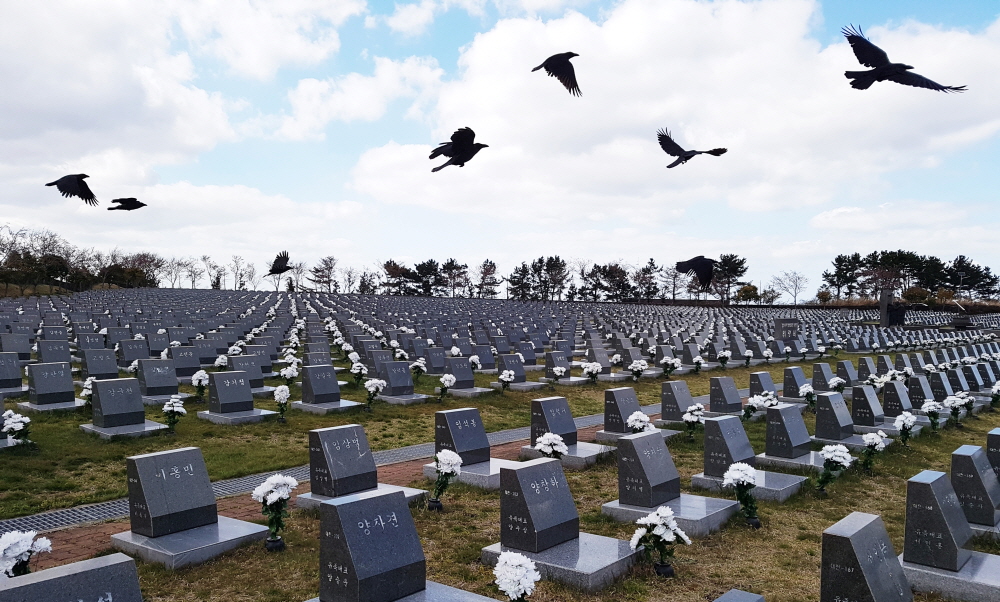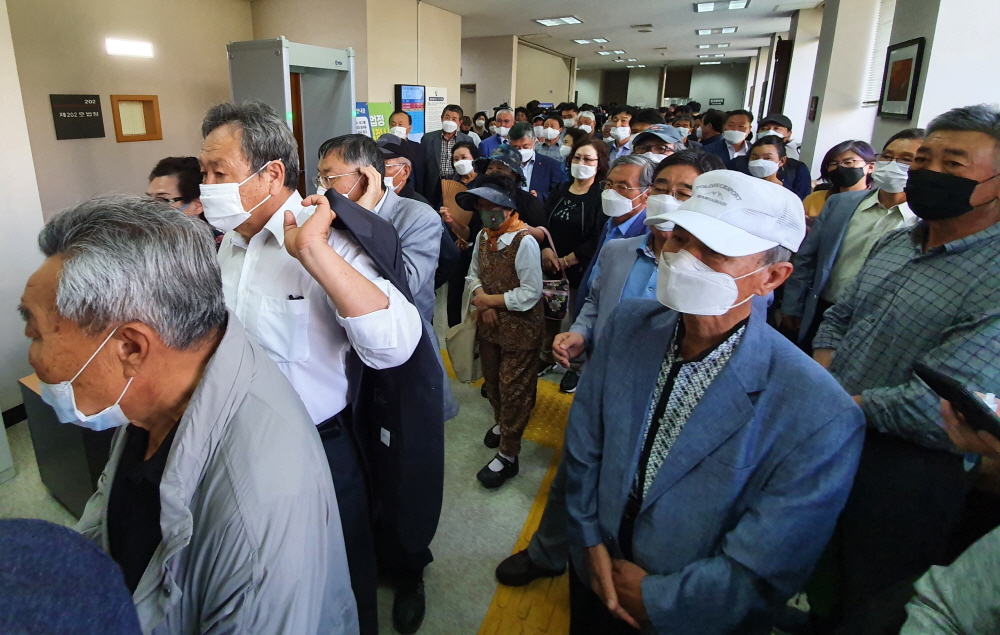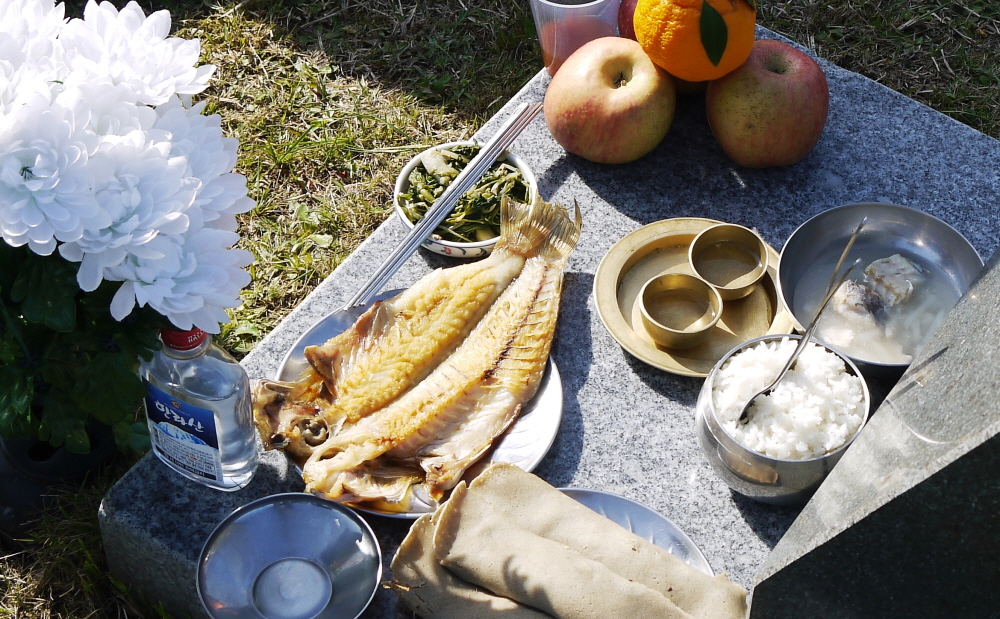May their 70-year-old “red tag” be soon removed

Tombstone Park for the Missing, where 3,973 tombstones for the missing Jeju 4·3 victims stand in the Jeju 4·3 Peace Park.
Heo Ho-joon, Senior correspondent with The Hankyoreh
Many of those who were forced to leave South Korea’s southern island of Jeju during Jeju 4·3 as falsely convicted prisoners would never return. Prior to being ripped from their homelands, some had never stepped foot off the island their entire lives. Others had previously gone to Japan or elsewhere as conscripted soldiers or laborers or for job opportunities, and returned following Korea’s national liberation in 1945, many dreaming of building a happy life in their newly freed nation. Some who were forced to leave were only teenage students. However, sometime between 1948 and 1949, they were forced to leave behind their newborn sons, daughters, wives, all of their loved ones as they were flung aside like used luggage upon worn out vessels to sail across the Jeju seas, to never see Hallasan Mountain again.
Many years have since passed. The naive infants, who were nestled in the bosoms of their mothers who wailed out of fear and dread while their fathers, husbands, and brothers were taken away, are now in their mid-70s. They have far outgrown their fathers while their youthful mothers have continued to live 70 more years than their husbands, still keeping their loved ones in their hearts. However, the families left behind on Jeju Island, marked with a so-called red tag, just like a scarlet letter, have started to take action. They are now demanding the state authorities for the whereabouts of their husbands, fathers, and brothers.
On June 8, the Criminal Chamber 2 of the Jeju District Court held the first court hearing on 14 of the so-called missing Jeju 4·3 prisoners. These people went missing more than 70 years ago while serving prison terms on charges of committing insurrection or violating Article 32 and 33 of the Articles of War (acts of protecting, giving intelligence to, communicating or corresponding with, or spying for the enemy). In June of 2019 and in February 2020, a total of 349 people applied for a retrial concerning the convictions of Jeju 4·3 missing people. It is an unprecedented scale for a retrial application in Korea. The judicial panel thus decided to proceed with the trial by sorting the applicants based on whether they have a relatively clear memory of the facts related to the case. The court will continue the trial in September 2020.
■ Who are the “missing Jeju 4·3 prisoners?”
During Jeju 4·3, residents of Jeju Island tried to survive by either hiding or taking refuge, particularly in the mountains. Later, after the authorities urged them down from the mountains or they were arrested by the constabulary forces while working in their fields, Jeju islanders were detained in concentration camps. The detainees were first severely tortured and then referred to court martials (military tribunals) held in December 1948 or in June to July 1949 before they were taken to mainland prisons. The mainland, to the islanders, was a place of banishment. However, the prisoners from Jeju knew nothing about their charges, nor sentences. Those left on the island who remained ill-informed of the whereabouts of their missing family members, finally heard from them one day by postcard or letter. Even this type of news stopped after the outbreak of the Korean War. And more than 70 years have now since passed. The prisoners described herein are referred to as the “victims who disappeared due to Jeju 4·3” or the “missing Jeju 4·3 prisoners.”
The List of the Convicts held by the National Archives of Korea documents the personal information of 2,530 prisoners as well as where they were imprisoned. Excluding the 384 people who were executed after being sentenced to death, the remaining convicts were scattered throughout the country to serve their prison terms. After the Korean War broke out, many of them were massacred as “impure elements” or they disappeared with the opening of the prison gates. The Tombstone Park for the Missing in the Jeju 4·3 Peace Park has 3,973 memorial stones for those who disappeared on Jeju Island or while being imprisoned after the trials.

On June 8, the plaintiffs suing for a retrial and other bereaved families of the missing prisoners gather at the Jeju District Court to attend the first court hearing.
■ What are the issues of the lawsuit to request a retrial?
The lawsuit to request a retrial presumes that the missing victims have already passed away. Thus, the claimants and their lawyers will need to prove those who disappeared more than 70 years ago have actually died. Additionally, it is necessary to prove that some of the missing people listed under different names or with different addresses are actually the same as those who have been reported to be missing. With regard to this, the judicial panel stated: “Even if the defendants survived [Jeju 4·3], there is little possibility that they are still alive since they would be aged in their late 90s or over in their 100s. Due to procedural regulations, however, whether they are alive needs to be checked.” The court asked the lawyers to submit written opinions to prove the deaths of the defendants.
The lawyers’ plan is to concentrate on proving their deaths by prison records. Lawyer Moon Seong-yoon, who is leading the lawsuit, said, “Records of the execution by firing squad of the prisoners have been clarified in some prisons while others lack clear record. Prior to the retrial, it is a key issue to prove that the missing victims are dead from a statutory perspective.”
Concerning those who were sentenced to death, the lawyers will submit as evidence the results of DNA tests of the remains that were exhumed from under the current Jeju International Airport site. It is deemed viable to prove the deaths of the prisoners of the Daejeon and the Daegu prisons. The state-related 2003 Investigation Report of the Jeju 4·3 Incident and the First Half of 2010 Investigation Report released by the Committee on Resolving Part Incidents for Truth and Reconciliation stated that none of the 300-plus Jeju 4·3-related prisoners returned from the Daejeon prison after the Korean War. The reports also mention that the Daegu prison transferred more than 200 Jeju 4·3-related prisoners to the military immediately after the war.
Lawyer Moon said, “Some were imprisoned in the facilities without a specific documentation. We will do our utmost to prove their deaths by highlighting that the Jeju 4·3 Peace Park has their tombstones and that their families have performed ancestral rites for decades, without hearing any news from the missing victims.”
Presumably, 15% of the “missing Jeju 4·3 prisoners” are “identical” to those who have been reported to be missing. According to Moon, some prisoners changed their names or addresses due to worries that their imprisonment might cause harm to their family members. “It will not be difficult to prove their identification,” he predicted.
In January of last year, surviving Jeju 4·3 prisoners filed a lawsuit to request a retrial. Unlike the retrial court ruling to dismiss their indictments, the lawsuit to request a retrial of the missing prisoners requires the participation of their spouses or lineal relatives. Due to the absence of the persons directly involved in the case, it is inevitably limited to the testimonies at court about the situations of the missing prisoners.
Although their spouses or lineal descendants are taking part in the lawsuit, most of their testimonies are based on what they heard from others. With few having witnessed the deaths of the prisoners, the bereaved families of the deceased will have difficulties presenting the evidence on their behalf.
■ What are the retrial procedures?
The procedures to determine whether or not to put the case to retrial will begin after the deaths of the deceased are proven. When confirming their deaths, the court will likely proceed with the case in the same order as the retrial on the surviving Jeju 4·3 prisoners. Professor Lee Jaeseung of Konkuk Law School stated, “During Jeju 4·3, residents of Jeju Island were unlawfully taken to be imprisoned in the state-run facilities. If they went missing, shouldn’t it be the state responsibility to prove their disappearance?”
Earlier in January of last year, the retrial court dismissed the indictments of 18 surviving Jeju 4·3 prisoners, which is regarded as a judgment of acquittal. The court ruling indicated that the convictions were invalid because the cases were tried without specifying the charges of the defendants. Moon said, “Rather than the applicants who were infants when the victims disappeared, we will ensure that siblings and spouses who have a clear memory of the victims or children who can make unquestionable testimonies for the examination of witnesses.”
■ What are the solutions?
If the court rules in favor of the missing prisoners, more lawsuits will likely follow by the bereaved family members of other missing victims. Apparently, the judicial panel has contemplated this issue, as evidenced by the question they asked in the first hearing held in June: “What is the current situation surrounding the bill on revising the Jeju 4·3 Special Act proposed at the National Assembly?” The court statement is interpreted as indicating the need for the National Assembly to enact the statutes related to the case. Professor Lee said, “A retrial allows for arguments about the confirmed court rulings concerning the incidents. The question is the validity of the court martial ruling during Jeju 4·3, which will determine the request for a retrial. This is why the Jeju 4·3 Bereaved Families Association and other related groups demand the nullification of the entire military tribunal verdicts by means of legislation.” Kim Kwang-woo, president of the Jeju 4·3 Missing Victims’ Bereaved Families Association, said, “Hopefully, our lawsuit for a retrial will be carried out seamlessly and eventually appease our pent-up sorrows.”
Moon said, “This case is much more difficult than the lawsuit concerning the surviving Jeju 4·3 prisoners because the people involved in the latter are alive. Still, we will make our most concerted efforts to win the case.”
The ruling Democratic Party lawmakers Oh Young-hun, Wi Seong-gon, and Song Jae-ho who represent constituencies of Jeju Island received written consents of 133 other members of the National Assembly. On July 27, they jointly proposed the revised bill of the Jeju 4·3 Special Act whose statutes specify the indemnification for the victims and the invalidation of the court martial rulings. Attention is paid on whether the bill, which was automatically denunciated during term of the 20th National Assembly, would be finally passed this time. It is now time for the bereaved families of the Jeju 4·3 victims and the other members of the local community to join forces.
